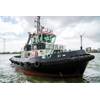New Product: Cylinder Scuffing Detection Tool

The CMT Scuffing Sensor monitoring a containership’s engine cylinder wear. Image courtesy CM Technologies
Ships trials reportedly confirmed that CM Technologies’ new scuffing sensor can detect early onset cylinder wear in marine diesel engines.
Trials onboard a number of large containerships and a two-stroke engine Baltic ferry showed it was possible to measure the friction in the cylinder when the engine is running.
CMT noted a trend in cylinder liner scuffing following the widespread use of 0-0.50% low sulphur fuel (LSF). These fuels together with insufficient or over lubrication, wrong feed rates or incorrect cylinder oil Base Number (BN) can see the oil film breakdown, causing adhesion, micro welds, corrosion, abrasion and metal-to-metal contact.
Similarly, advancements in combustion engine technology have required engines to operate with increased power density, higher loads, and higher combustion pressures and temperatures – parameters that result in a more demanding combustion and lubrication environment.
To alert operators to the condition of cylinder liners during engine operation, CMT embarked on an extensive research project to develop a reliable, rapid detection technology that uses acoustic emissions sensors to analyze the operating environment within the piston cylinder.
With no need to stop the engine to take readings, the sensor detects changes in high frequency vibration and stress waves when accumulated energy is rapidly released on the piston rings and cylinder liner’s surface.
CMT’s AE sensors – electromagnetic acoustic transducers with built-in amplifiers optimised to detect sound waves in the 300 to 700kHz range – expose and locate material crack formation, friction, delamination and cavitation, revealing underlying problems with the lubricant being used.
 The CMT Scuffing Sensor’s provide early warning of sudden severe cylinder wear. Image courtesy CM Technologies
The CMT Scuffing Sensor’s provide early warning of sudden severe cylinder wear. Image courtesy CM Technologies












